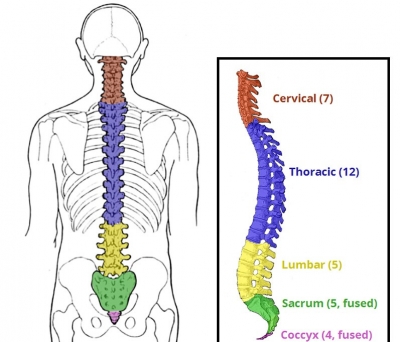
The vertebrae that make up the backbone are often divided into five regions:
Cervical vertebrae
The seven cervical vertebrae support the head, with the top two vertebrae, the atlas and axis, enabling the head to nod and turn.
Thoracic vertebrae
The 12 thoracic vertebrae connect with the ribs, forming the back of the ribcage. Each thoracic vertebra has two ‘demi facets,’ superiorly and inferiorly placed on either side of its vertebral body. The demi facets articulate with the heads of two different ribs.
Lumbar vertebrae
There are five lumbar vertebrae, which support most of the body’s weight. Lumbar vertebrae have very large vertebral bodies, which are kidney-shaped. They lack the characteristic features of other vertebrae, with no transverse foramina, costal facets, or bifid spinous processes.
Fused bones of the sacrum
A group of five bones connect the backbone to the pelvic girdle. It is described as an inverted triangle, with the apex pointing inferiorly. On the lateral walls of the sacrum are facets for articulation with the pelvis at the sacro-iliac joints.
Fused bones of the coccyx
These four bones are an attachment point for muscles, tendons, and ligaments. It is recognised by its lack of vertebral arches. Due to the lack of vertebral arches, there is no vertebral canal.
Picture Credit : Google




